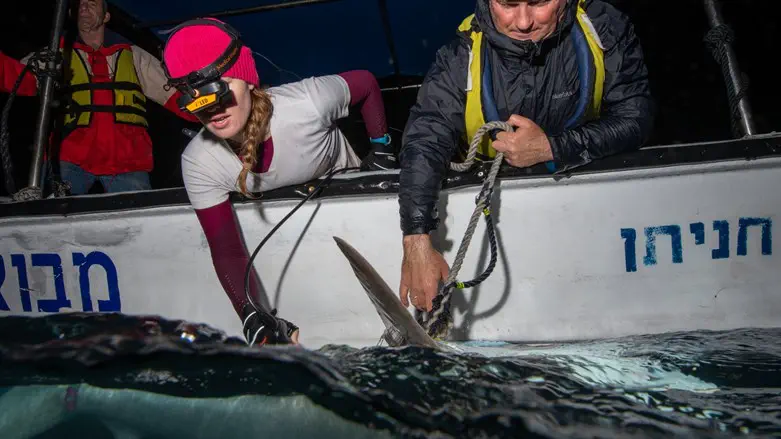
University of Haifa researchers have been awarded a $100,000 National Geographic Wayfinder Grant to track the movement of sharks along the eastern Mediterranean Sea (EMS), to try to understand why the species thrives along the basin despite the impact of climate change on the region.
The study, which is led by National Geographic Explorer Dr. Aviad Scheinin of University of Haifa’s Morris Kahn Marine Research Station and head of its Marine Apex Predator Laboratory, and Dr. Leigh Livne, postdoc at his lab, builds on established collaborations across the EMS to combine research with education for long-term conservation outcomes. The Wayfinder grant is crucial to pinpointing the movement and reproduction of sharks and why they return to specific hotspots year after year.
Using a range of minimally invasive satellite tags (including a “Birth Alert Tag” to find parturition grounds of sharks), a network of fixed acoustic receivers, a suite of biological analyses, and the collection of environmental metadata, researchers hope to find where sharks are migrating and residing year-round in the EMS.
The announcement of the National Geographic grant comes in advance of the Discovery Channel’s popular annual “Shark Week,” which takes place from July 23-30 this year.
The grant will fund the researchers' efforts to answer key questions such as: For what species-specific reasons do the two shark species use the warm water havens from the effluent waters of Hadera power plant cooling water in winter? Where do they go in the summer months?
“Through National Geographic’s influential platform, we can scale up our story to reach the hearts and minds of scientists, children, and decision makers alike,” Dr. Scheinin said. “This is a story about endangered species at the brink, and our ability to discover the secrets about where they are most likely to survive under changing climatic conditions. It can also highlight humanity’s ability to protect and sustain these populations for future generations.”
To date, Dr. Scheinin has tagged 103 sharks, and he is leading the Mediterranean’s first “Shark Tagging School” to deploy various state-of-the-art tags to monitor shark distribution. Most sharks have been tagged with acoustic transmitter tags, and his team has deployed a network of 10-15 passive acoustic receivers in areas of known aggregations along the Israeli coastal shelf.
Dr. Scheinin carefully built strong collaborations with shark researchers across the eastern Mediterranean to disseminate records and pinpoint crucial habitats that sandbar and dusky sharks are using. Now he has taken his work to Turkey to pilot a training school on proper catch-and-release protocols for sharks with fellow Turkish scientists, to teach them how to safely catch and monitor sharks in their waters. As such, Dr. Scheinin is working with a consortium of researchers focusing on shark aggregations affiliated with universities in Turkey, the European Aquatic Animal Tracking Network, and the Mediterranean Conservation Society.
The school was conceived as a solution to address the knowledge gap on distribution of the Israeli-tagged sharks and prompted the long-standing collaboration between Dr. Scheinin and his Turkish partners. Through training other shark researchers on how to safely and ethically catch-tag-and-release sharks, researchers expect this knowledge to be disseminated over the coming years and kick-start the expansion of tagging efforts even further west. This work will yield practical results to aid the conservation of these impacted species.
Since sharks know no political borders, the researchers’ network of partners is seeking to provide science-based evidence to policymakers with the goal of enacting similar national-level protections for their shark aggregations that already exist in Israel.
To date, Israel is the only country that protects all elasmobranch species (sharks and rays) within its maritime borders where two shark species aggregate around the warm water effluent from coastal power stations, making access ideal for study. Since 2016, Dr. Scheinin has collected biological, morphometric, and passive acoustic data to estimate the health and distribution of both sandbar and dusky sharks. Sandbar sharks are endangered and the Dusky sharks are data deficient in the Mediterranean Sea according to the IUCN red list.
This is significant because the EMS basin serves as a model for other marine regions as the effects of climate change become ever more apparent, giving researchers a unique opportunity to understand species' requirements, as habitats in the EMS exist in a “post-warming” state.
Finally, another aspect of the study is being coordinated by Dr. Scheinin’s postdoctoral student Dr. Leigh Livne. Her aspect of the research will focus on conservation physiology of sharks in the eastern Mediterranean, using a range of hormone and blood biochemical markers, as well as ultrasonography, to determine the fecundity and maternal condition of the sharks. A part of the Israeli shark tagging team since 2019, she will assist Dr. Scheinin with implementing the catch-and-release training and sampling on-board, as well as analyzing the data for meaningful conclusions which will benefit both species' conservation.
With Shark Week coming up later this month, Dr. Livne welcomes pop culture’s interest in sharks, especially since that fascination is starting to shift from seeing sharks as threats to humanity exclusively.“I think the danger aspect of sharks is a bit sensational,” Livne said. “In the 70s and 80s, when the movie Jaws came out, the idea of sharks as predators dominated the conversation. Now, the public is learning more about what scientists have been saying for decades and that is that sharks are very important to our ecosystem. They're a stabilizing force and are critical to maintaining ecological balance in marine life.”



